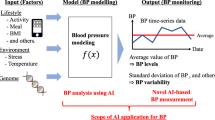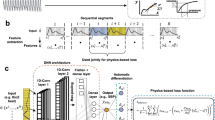Abstract
Hypertension is the leading cause of cardiovascular complications. This review focuses on the advancements in medical artificial intelligence (AI) models aimed at individualized treatment for hypertension, with particular emphasis on the approach to time-series big data on blood pressure and the development of interpretable medical AI models. The digitalization of daily blood pressure records and the downsizing of measurement devices enable the accumulation and utilization of time-series data. As mainstream blood pressure data shift from snapshots to time series, the clinical significance of blood pressure variability will be clarified. The time-series blood pressure prediction model demonstrated the capability to forecast blood pressure variabilities with a reasonable degree of accuracy for up to four weeks in advance. In recent years, various explainable AI techniques have been proposed for different purposes of model interpretation. It is essential to select the appropriate technique based on the clinical aspects; for example, actionable path-planning techniques can present individualized intervention plans to efficiently improve outcomes such as hypertension. Despite considerable progress in this field, challenges remain, such as the need for the prospective validation of AI-driven interventions and the development of comprehensive systems that integrate multiple AI methods. Future research should focus on addressing these challenges and refining the AI models to ensure their practical applicability in real-world clinical settings. Furthermore, the implementation of interdisciplinary collaborations among AI experts, clinicians, and healthcare providers are crucial to further optimizing and validate AI-driven solutions for hypertension management.

This is a preview of subscription content, access via your institution
Access options
Subscribe to this journal
Receive 12 print issues and online access
$259.00 per year
only $21.58 per issue
Buy this article
- Purchase on Springer Link
- Instant access to full article PDF
Prices may be subject to local taxes which are calculated during checkout


Similar content being viewed by others
References
Rossier BC, Bochud M, Devuyst O. The hypertension pandemic: an evolutionary perspective. Physiology. 2017;32:112–125. https://doi.org/10.1152/physiol.00026.2016.
Parati G, Lombardi C, Pengo M, Bilo G, Ochoa JE. Current challenges for hypertension management: from better hypertension diagnosis to improved patients’ adherence and blood pressure control. Int J Cardiol. 2021;331:262–269. https://doi.org/10.1016/j.ijcard.2021.01.070.
Louca P, Tran TQB, Toit du CD, Christofidou P, Spector TD, Mangino M, et al. Machine learning integration of multimodal data identifies key features of blood pressure regulation. EBiomedicine. 2022;84:104243. https://doi.org/10.1016/j.ebiom.2022.104243.
Chiang P-H, Wong M, Dey S. Using wearables and machine learning to enable personalized lifestyle recommendations to improve blood pressure. IEEE J Transl Eng Heal Med. 2021;9:1–13. https://doi.org/10.1109/jtehm.2021.3098173.
Mueller FB. AI (artificial intelligence) and hypertension research. Curr Hypertens Rep. 2020;22:70. https://doi.org/10.1007/s11906-020-01068-8.
Kario K. Management of hypertension in the digital era: small wearable monitoring devices for remote blood pressure monitoring. Hypertension. 2020;76:640–650. https://doi.org/10.1161/HYPERTENSIONAHA.120.14742.
Stergiou GS, Mukkamala R, Avolio A, Kyriakoulis KG, Mieke S, Murray A, et al. European Society of Hypertension Working Group on Blood Pressure Monitoring and Cardiovascular Variability. Cuffless blood pressure measuring devices: review and statement by the European Society of Hypertension Working Group on Blood Pressure Monitoring and cardiovascular Variability. J Hypertens. 2022;40:1449–1460. https://doi.org/10.1097/HJH.0000000000003224.
López-Martínez F, Núñez-Valdez ER, Crespo RG, García-Díaz V. An artificial neural network approach for predicting hypertension using NHANES data. Sci Rep. 2020;10:10620. https://doi.org/10.1038/s41598-020-67640-z.
Koshimizu H, Kojima R, Kario K, Okuno Y. Prediction of blood pressure variability using deep neural networks. Int J Med Inf. 2020;136:104067. https://doi.org/10.1016/j.ijmedinf.2019.104067.
Chu G, Zhang Z, Xu M, Huang D, Dai Q. Validation of a smartphone auscultatory blood pressure kit Accutension XYZ-110 in adults according to the ANSI/AAMI/ISO 81060-2. Blood Press Monit. 2017;22:290–294. https://doi.org/10.1097/MBP.0000000000000268.
Padmanabhan S, Tran TQB, Dominiczak AF. Artificial intelligence in hypertension: seeing through a glass darkly. Circ Res. 2021;128:1100–1118. https://doi.org/10.1161/CIRCRESAHA.121.318106.
Niiranen TJ, Hänninen M-R, Johansson J, Reunanen A, Jula AM. Home-measured blood pressure is a stronger predictor of cardiovascular risk than office blood pressure. Hypertension. 2010;55:1346–1351. https://doi.org/10.1161/hypertensionaha.109.149336.
Kario K, Nomura A, Harada N, Okura A, Nakagawa K, Tanigawa T, et al. Efficacy of a digital therapeutics system in the management of essential hypertension: the HERB-DH1 pivotal trial. Eur Heart J. 2021;42:4111–4122. https://doi.org/10.1093/eurheartj/ehab559.
Kario K, Shimbo D, Tomitani N, Kanegae H, Schwartz JE, Williams B. The first study comparing a wearable watch‐type blood pressure monitor with a conventional ambulatory blood pressure monitor on in‐office and out‐of‐office settings. J Clin Hypertens. 2020;22:135–141. https://doi.org/10.1111/jch.13799.
Kokubo A, Kuwabara M, Nakajima H, Tomitani N, Yamashita S, Shiga T, et al. Automatic detection algorithm for establishing standard to identify “surge blood pressure. Med Biol Eng Comput. 2020;58:1393–1404. https://doi.org/10.1007/s11517-020-02162-4.
Parati G, Bilo G, Kollias A, Pengo M, Ochoa JE, Castiglioni P, et al. Blood pressure variability: methodological aspects, clinical relevance and practical indications for management – a European Society of Hypertension position paper∗. J Hypertens. 2023;41:527–544. https://doi.org/10.1097/HJH.0000000000003363.
Umemura S, Arima H, Arima S, Asayama K, Dohi Y, Hirooka Y, et al. The Japanese Society of Hypertension guidelines for the management of hypertension (JSH 2019). Hypertens Res. 2019;42:1235–1481. https://doi.org/10.1038/s41440-019-0284-9.
Whelton PK, Carey RM, Aronow WS, Casey DE Jr, Collins KarenJ, Dennison Himmelfarb C, et al. 2017 ACC/AHA/AAPA/ABC/ACPM/AGS/APhA/ASH/ASPC/NMA/PCNA guideline for the prevention, detection, evaluation, and management of high blood pressure in adults: a report of the American College of Cardiology/American Heart Association Task Force on clinical practice guidelines. Circulation. 2018;138:e426–e483. https://doi.org/10.1161/HYP.0000000000000065.
Williams B, Mancia G, Spiering W, Agabiti Rosei E, Azizi M, Burnier M, et al. 2018 Practice Guidelines for the management of arterial hypertension of the European Society of Cardiology and the European Society of Hypertension. J Hypertens 2018;36:2284–2309. https://doi.org/10.1093/eurheartj/ehy339. List of authors/Task Force members
Monahan M, Jowett S, Lovibond K, Gill P, Godwin M, Greenfield S, et al. Predicting out-of-office blood pressure in the clinic for the diagnosis of hypertension in primary care. Hypertension. 2018;71:250–261. https://doi.org/10.1161/hypertensionaha.117.10244. investigators P-B
Fleischhauer V, Feldheiser A, Zaunseder S. Beat-to-beat blood pressure estimation by photoplethysmography and its interpretation. Sensors. 2022;22:7037. https://doi.org/10.3390/s22187037.
Tan P, Xi Y, Chao S, Jiang D, Liu Z, Fan Y, et al. An artificial intelligence-enhanced blood pressure monitor wristband based on piezoelectric nanogenerator. Biosensors. 2022;12:234. https://doi.org/10.3390/bios12040234.
Mukkamala R, Yavarimanesh M, Natarajan K, Hahn J-h, Kyriakoulis KG, Avolio AP, et al. Evaluation of the accuracy of cuffless blood pressure measurement devices: challenges and proposals. Hypertension. 2021;78:1161–1167. https://doi.org/10.1161/HYPERTENSIONAHA.121.17747.
Stergiou GS, Alpert B, Mieke S, Asmar R, Atkins N, Eckert S, et al. A universal standard for the validation of blood pressure measuring devices. Hypertension. 2018;71:368–374. https://doi.org/10.1161/HYPERTENSIONAHA.117.10237.
Mukkamala R. Blood pressure with a click of a camera? Circ Cardiovasc Imaging. 2019;12:e009531. https://doi.org/10.1161/CIRCIMAGING.119.009531.
Narita K, Hoshide S, Ae R, Kario K. Simple predictive score for nocturnal hypertension and masked nocturnal hypertension using home blood pressure monitoring in clinical practice. J Hypertens. 2022;40:1513–1521. https://doi.org/10.1097/HJH.0000000000003175.
Shih L-C, Wang Y-C, Hung M-H, Cheng H, Shiao Y-C, Tseng Y-H, et al. Prediction of white-coat hypertension and white-coat uncontrolled hypertension using machine learning algorithm. Eur Hear J Digit Heal. 2022;3:ztac066 https://doi.org/10.1093/ehjdh/ztac066.
Hung MH, Shih LC, Wang YC, Leu HB, Huang PH, Wu TC, et al. Prediction of masked hypertension and masked uncontrolled hypertension using machine learning. Front Cardiovasc Med. 2021;8:778306 https://doi.org/10.3389/fcvm.2021.778306.
Li X, Wu S, Wang L. Blood pressure prediction via recurrent models with contextual layer. In: Proceedings of 26th International Conference World Wide Web. 2017; 685–693. https://doi.org/10.1145/3038912.3052604.
Breiman L. Statistical modeling: the two cultures (with comments and a rejoinder by the author). Stat Sci. 2001;16. https://doi.org/10.1214/ss/1009213726.
Krishnapuram B, Shah M, Smola A, Aggarwal C, Shen D, Rastogi R, et al. “Why should I Trust You?” In: Proceedings 22nd ACM SIGKDD International Conference on Knowledge Discovery and Data Mining. 2016; 1135–1144. https://doi.org/10.1145/2939672.2939778.
Lundberg S, Lee S-I. A unified approach to interpreting model predictions. Arxiv. 2017, https://arxiv.org/abs/1705.07874.
Lundberg SM, Nair B, Vavilala MS, Horibe M, Eisses MJ, Adams T, et al. Explainable machine-learning predictions for the prevention of hypoxaemia during surgery. Nat Biomed Eng. 2018;2:749–760. https://doi.org/10.1038/s41551-018-0304-0.
Oikonomou EK, Spatz ES, Suchard MA, Khera R. Individualising intensive systolic blood pressure reduction in hypertension using computational trial phenomaps and machine learning: a post-hoc analysis of randomised clinical trials. Lancet Digit Health. 2022;4:e796–e805. https://doi.org/10.1016/S2589-7500(22)00170-4.
Wachter S, Mittelstadt B, Russell C. Counterfactual explanations without opening the black box: automated decisions and the GDPR. SSRN Electron J. 2017; https://doi.org/10.2139/ssrn.3063289.
Wallisch C, Agibetov A, Dunkler D, Haller M, Samwald M, Dorffner G, et al. The roles of predictors in cardiovascular risk models – a question of modeling culture? BMC Med Res Methodol. 2021;21:284 https://doi.org/10.1186/s12874-021-01487-4.
Dandl S, Molnar C, Binder M, Bischl B. Multi-objective counterfactual explanations. Arxiv. 2020;448–469. https://doi.org/10.1007/978-3-030-58112-1_31.
Nakamura K, Kojima R, Uchino E, Ono K, Yanagita M, Murashita K, et al. Health improvement framework for actionable treatment planning using a surrogate Bayesian model. Nat Commun. 2021;12:3088 https://doi.org/10.1038/s41467-021-23319-1.
Author information
Authors and Affiliations
Corresponding authors
Ethics declarations
Conflict of interest
Employment: HirosKos (Omron Healthcare Co., Ltd.); Research fund: HirohKoh, YO (Omron Healthcare Co., Ltd.).
Additional information
Publisher’s note Springer Nature remains neutral with regard to jurisdictional claims in published maps and institutional affiliations.
Rights and permissions
Springer Nature or its licensor (e.g. a society or other partner) holds exclusive rights to this article under a publishing agreement with the author(s) or other rightsholder(s); author self-archiving of the accepted manuscript version of this article is solely governed by the terms of such publishing agreement and applicable law.
About this article
Cite this article
Kohjitani, H., Koshimizu, H., Nakamura, K. et al. Recent developments in machine learning modeling methods for hypertension treatment. Hypertens Res 47, 700–707 (2024). https://doi.org/10.1038/s41440-023-01547-w
Received:
Revised:
Accepted:
Published:
Issue Date:
DOI: https://doi.org/10.1038/s41440-023-01547-w



